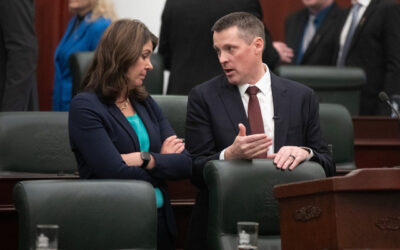Province balances budget for third straight year
By Al Beeber - Lethbridge Herald on June 28, 2024.
 Premier Danielle Smith and Finance Minister Nate Horner speak before delivering the 2024 budget in Edmonton, Thursday, Feb. 29, 2024. The final numbers are in for the fiscal year that ended in March in Alberta, and the bottom line is a $4.3-billion surplus. THE CANADIAN PRESS/Jason Franson
Premier Danielle Smith and Finance Minister Nate Horner speak before delivering the 2024 budget in Edmonton, Thursday, Feb. 29, 2024. The final numbers are in for the fiscal year that ended in March in Alberta, and the bottom line is a $4.3-billion surplus. THE CANADIAN PRESS/Jason FransonLETHBRIDGE HERALDabeeber@lethbridgeherald.com
Alberta has balanced its budget for the third straight year ending it with a $4.3 million surplus.
The provincial government released its year end-report on Thursday.
The province says its strategy has earned it credit rating upgrades “from multiple firms, including Fitch’s recent upgrade to AA.”
As of March 31, the province had $7.3 billion in surplus cash, $3.7 billion of which is being allocated to debt repayment with $1.7 billion repaid in the 2023-24 fiscal year and another $2 billion coming in 2024-25, says the province this being part of its strategy to reduce the debt burden on residents.
The information is contained in a report that was embargoed until a Thursday news conference by Finance Minister Nate Horner.
“Our government has kept its promise to balance our budget and provide Albertans the services and supports they need,” said Horner in a statement Thursday.
“We will keep building opportunity so that our children and grandchildren can continue to benefit, grow and share in the province’s prosperity.”
Taxpayer supported debt as of March 31 this year was $81.8 billion.
The market value of the Heritage fund has grown to a record high of $22.9 billion, says the government, a figure that includes $1.7 billion in annual investment earnings. The province says $2 billion in surplus cash has been set aside to further grow the fund this year.
The government’s long-term goal is to have the fund grow to between $250 billion and $400 billion by 2050.
Total revenue in 2023-24 was $74.7 billion, which was $4.1 billion higher than estimated in the 2023 budget. Of that $74.7 billion, $19.3 billion was in the form of non-renewable resource revenue.
The province generated $15.2 billion from personal income taxes which it says was “driven by Alberta’s robust labour market underpinned by strong population growth.”
Total provincial expense for 2023-24 was $70.4 billion, which was $2.1 billion higher than the budget estimate.
The province says $1.1 billion more were generated in corporate income taxes than forecast in the 2023 budget but those taxes were $1.1 billion less in 2022-23 due to softer corporate profits and weaker commodity prices.
The province delivered $3 billion in emergency and disaster response which included $1.9 billion in insurance payments to assist farmers and producers dealing with drought. Another $1.1 billion was used in response to wildfires.
The province spent $27.2 billion on health, $9.4 billion for K-12 education and $6.8 billion for post-secondary education.
Social services spending, including indexation of social benefit programs, amounted to $8 billion.
The province says there is a $1.1 billion increase in operating expenses since the budget which is due largely to the help being provided to schools and post-secondary institutions with enrolment pressures and to address pressures in the health system.
In 2023-24, the government said spending on health care and education was the highest ever.
There was employment growth of 3.6 per cent and population growth of an amount not seen since 1981, says the year-end results.
Challenges on the province include pressures on housing, public services and other infrastructure as well as the increased cost of living for Albertans due to inflation. That inflation is also putting pressures on government programs, says the province.
The year-end report shows transfers from the federal government were $12.3 billion, which was $0.2 billion lower than in the 2023 budget due to lower infrastructure support revenue because of delays in municipal projects a lower than expected Canada Health Transfer and lower child care transfers. There were some offsetting increases in agriculture support and other transfers, however.
– with files from The Canadian Press
25-24


